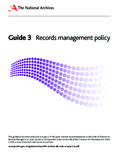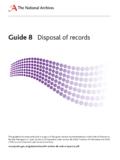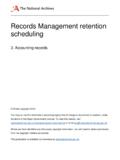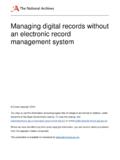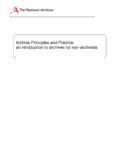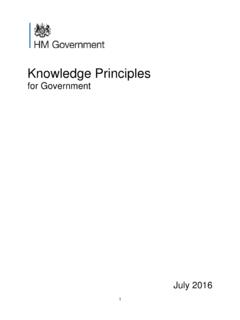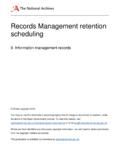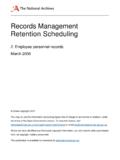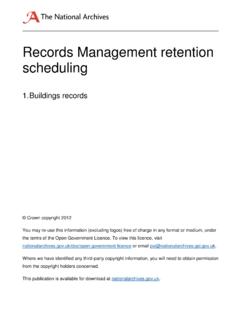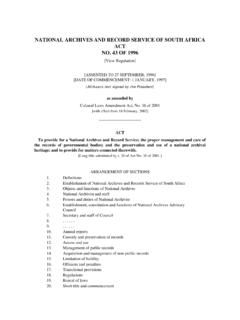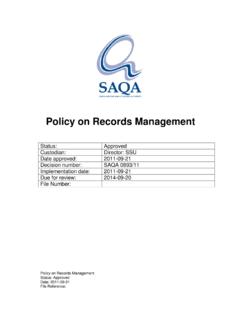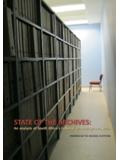Transcription of Access to Public Records - The National Archives
1 Access to Public Records A toolkit for practitioners involved in the sensitivity review and transfer of Public Records to The National Archives and other Archives services December 2015 Crown copyright 2015 You may re-use this information (excluding logos) free of charge in any format or medium, under the terms of the Open Government Licence. To view this licence, visit or email Where we have identified any third-party copyright information, you will need to obtain permission from the copyright holders concerned. This publication is available for download at Access to Public Records Last updated December 2015 Page 2 of 34 Contents Purpose of toolkit.
2 3 What are Public Records , and who is responsible for them? .. 3 Principles for determining Access status of Records on transfer .. 6 Freedom of information exemptions .. 8 Summary of FOI Exemptions .. 9 Information exemptions (exceptions) in the Environmental Information Regulations .. 14 Data Protection and personal information .. 15 Procedures for closure on transfer .. 18 Records outside The National Archives .. 20 Places of Deposit .. 20 Temporary return to the department .. 21 Public Records stored by contractors/specialist storage but in the custody of The National Archives .
3 21 Retention of Public Records by departments .. 22 Legal position .. 22 Categories of retained documents .. 23 Guidelines on retention .. 24 Annex A Advisory Council on National Records and Archives .. 26 Annex B Redaction .. 28 Annex C Closed descriptions .. 30 Annex D Statute bars .. 31 Annex E List of URLs in this document .. 32 Access to Public Records Last updated December 2015 Page 3 of 34 Purpose of toolkit Records are transferred to The National Archives and places of deposit under the Public Records Act 1958. With the full implementation of the Freedom of Information Act 2000 (FOIA) in January 2005, Public Access to Records held by Archives services and the basis for their closure on transfer was altered substantially.
4 The Thirty Year Access Rule was abolished and the previous manual s guidance on extended closure and accelerated opening provisions was superseded. The FOIA now governs Public Access to Public Records . When the information in those Records is environmental information as defined in the Environmental Information Regulations 2004, Public Access is governed by those Regulations, which are similar but not identical to the FOIA. For simplicity FOIA is used throughout this toolkit and Environmental Information Regulations specified only when provisions differ. The Information Commissioner s Office (ICO) issues guidance on FOIA exemptions (the reasons to withhold information).
5 The Department for the Environment, Food and Rural Affairs (Defra) issues guidance on the Environmental Information Regulations. Part 2 of the code of practice on the management of Records under section 46 of the FOIA sets out how Records should be transferred to Archives services. The aim of this toolkit is to supplement advice regarding the transfer of Public Records to Archives services. It is a reference tool for use by those involved in the sensitivity review of Records and the transfer of closed Records . The guidance is intended primarily for the transfer of Public Records held by government departments to The National Archives or other approved places of deposit but the principles and examples may also be relevant to the transfer of non- Public Records .
6 The FOIA has changed the legal framework governing Access to all government information. We will revise this toolkit periodically to take note of precedents and other changes in legislation into account. What are Public Records , and who is responsible for them? Public Records are Records that fall within the scope of the Public Records Act 1958 (PRA) as set out in Schedule 1 to that act. They are Records created or received by government departments and their executive agencies, the armed forces, NHS authorities and the courts. They include the Records of non-departmental Public bodies (NDPBs) if they are Crown property but not those of bodies that own Records in their own right, unless the NDPB is listed in the table following paragraph 3 of Schedule 1 to the PRA.
7 Access to Public Records Last updated December 2015 Page 4 of 34 There are some explicit exclusions, for example registers of births, marriages, deaths and adoption; Records wholly or mainly relating to Scottish affairs; and the permanent collections of Public record museums and galleries. The act also gives the Secretary of State the power to determine whether a body s Records are Public Records or not and for bodies to be made Public record bodies by Order in Council. Scotland and Northern Ireland have their own record offices and legislative provisions for Archives .
8 The National Assembly for Wales has the power to establish a record office for Wales but has not yet done so. The Chief Executive of The National Archives as Keeper of Public Records has the responsibility of coordinating and supervising the selection and transfer of Records to The National Archives . Once Records are in The National Archives , the Keeper is charged with preserving them, providing catalogues and indexes, allowing the Public to consult them, providing copies of them, and lending them to exhibitions. Although the Keeper has custody of transferred Records , departments can request the temporary return of documents transferred by them.
9 Every person responsible for Public Records must select those worthy of permanent preservation and transfer them to The National Archives or a place of deposit approved by the Secretary of State. Only a small fraction of Public Records are identified as suitable for permanent preservation in The National Archives or in places of deposit, and the great majority of those not selected are destroyed. The National Archives Records Collection Policy has been formulated in consultation with a broad spectrum of interest groups and are available from The National Archives .
10 Legislative context Most of the law relating to Public Records is found in the Public Records Act 1958 and the Freedom of Information Act 2000. The 1958 Act transferred responsibility for Public Records from the Master of the Rolls to the Lord Chancellor and established the post of Keeper of Public Records in its current form. The act provided that the Public Records selected for permanent preservation were to be transferred to The National Archives or to a place of deposit no later than 30 years after their creation. When they had been in existence for 50 years they were to be available for Public inspection, unless action was taken to withhold them for longer.
